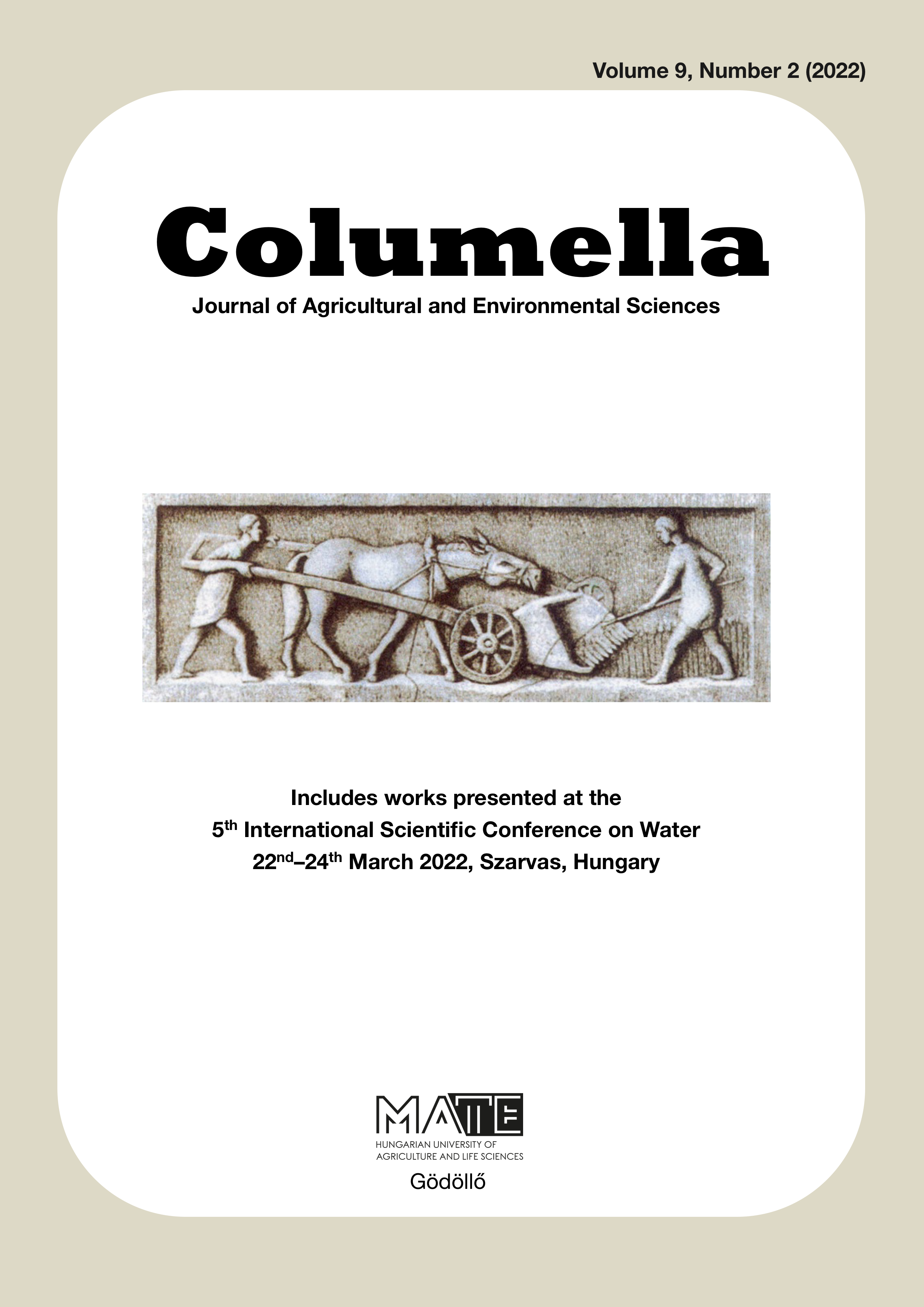Characteristics of Groundwater Level in the Szarvas-Békésszentandrás Oxbow Subbasin
DOI:
https://doi.org/10.18380/SZIE.COLUM.2022.9.2.13Keywords:
groundwater level, trend, long-term, annual courseAbstract
The shallow groundwater has a direct and indirect effect on natural vegetation and agricultural production. The decline in groundwater level (GWL) can have negative impacts. In many areas in Hungary decreasing GWL trends in the last decades were found by earlier studies. In our research we studied the characteristics of groundwater level focusing on our study area, the subbasin of Szarvas-Békésszentandrás Oxbow. We analysed 20 years daily data of groundwater level of eight monitoring wells. Annual course and long term tendencies of groundwater level were examined. In average of 16 years the GWL reaches its maximum in April and its deepest level in autumn (September, October and November depending on the station). Four typical groups of groundwater level courses could be distinguished based on the average depth and seasonal variations of GWL. The year to year GWL variability is larger in January and April compared to July and especially to October. The trends of the middle months of the seasons are almost the same in significance and slope compared to the trends based on yearly mean time series. The differences in trends can be found between stations rather than between the months used for calculations. The larger part of the subbasin can be characterised by decreasing trend in groundwater levels (2002-2020). The change exceeds 1 m at station Szarvas 2832 (144 cm) and Szarvas 2778 (122 cm). However, there is a station with no significant trend, GWL at Csabacsűd 2779 station shows relative stability in yearly average, which is valid for some areas in the eastern part of the subbasin.
References
Abliz, A., Tiyip, T., Ghulam, A., Halik, Ü., li Ding, J., Sawut, M., . . . Abliz, A. (2016). Effects of shallow groundwater table and salinity on soil salt dynamics in the Keriya Oasis, Northwestern China. Environmental Earth Sciences 75(3), 260. doi: https://doi.org/10.1007/s12665-015-4794-8
Hao, Y., Xie, Y., Ma, J., & Zhang, W. (2017). The critical role of local policy effects in arid watershed groundwater resources sustainability: A case study in the Minqin oasis, China. Science of The Total Environment 601-602(1), 1084-1096. doi: https://doi.org/10.1016/j.scitotenv.2017.04.177
Kovács, F. (2014). A csapadékváltozás és a talajvízszint alakulás kapcsolatáról. Hidrológiai Közlöny 94(1), 46-50.
Kovács, F., & Turai, E. (2004). Csapadék és talajvízszint értékek spektrális elemzése a mezőkeresztesi adatok alapján. Miskolci Egyetem Közleménye A sorozat, Bányászat 66(1), 3-14.
Li, H., Lu, Y., Zheng, C., Zhang, X., Zhou, B., & Wu, J. (2020). Seasonal and Inter-Annual Variability of Groundwater and Their Responses to Climate Change and Human Activities in Arid and Desert Areas: A Case Study in Yaoba Oasis, Northwest China. Water 12(1), 303. doi: https://doi.org/10.3390/w12010303
Molnár, G., & Winter, J. (1983). A talajvizek alakulása a Nagykunságban és a Jászságban. Hidrológiai Közlöny 63(10), 450-458.
Nyizsalovszki, R., & Szabó, S. (2003). A talajvízszint mozgásának idő- és térbeli változásai egy hegylábi mintaterületen. Földrajzi Értesítő 52(1-2), 23-36.
Pálfai, I. (1996). A talajnedvesség és a talajvízállás változásai az Alföldön. Vízügyi Közlemények 78(2), 207-218.
Pálfai, I. (2010). A Duna–Tisza közi hátság vízháztartási sajátosságai. Hidrológiai Közlöny 90(1), 40-44.
Rétháti, L. (1983). A talajvíz évi szélső vízállásainak időpontja. Hidrológiai Közlöny 63(12), 525-572.
Salmi, T., Määttä, A., Anttila, P., Ruoho-Airola, T., & Amnell, T. (2002). Detecting trends of annual values of atmospheric pollutants by the mann-kendall test and sen’s slope estimates makesens–the excel template application (Tech. Rep.). Helsinki, Finland: Finish Meteorological Institute.
Stelczer, K. (2000). A vízkészlet-gazdálkodás hidrológiai alapjai. Budapest: ELTE Eötvös Kiadó.
Szalai, J. (2011). Talajvízszint változások az Alföldön. In J. Rakonczai (Ed.), A környezeti változások és az Alföld (Vol. 7, p. 97-110). Békéscsaba: Nagyalföld Alapítvány.
Szalóki, S. (1994). A talajvízszint süllyedés következményei a növénytermesztésben. In I. Pálfai (Ed.), A Duna-Tisza közi hátság vízgazdálkodási problémái (Vol. 1, p. 53-58). Békéscsaba: Nagyalföld Alapítvány.
Yan, B., Li, X., Hou, J., Bi, P., & Sun, F. (2021). Study on the dynamic characteristics of shallow groundwater level under the influence of climate change and human activities in Cangzhou, China. Water Supply 21(2), 797–814. doi: https://doi.org/10.2166/ws.2020.308
Downloads
Published
Issue
Section
License
Copyright (c) 2022 Béla Gombos, Ildikó Szalókiné Zima, Erzsébet Csengeri

This work is licensed under a Creative Commons Attribution-NonCommercial-NoDerivatives 4.0 International License.






